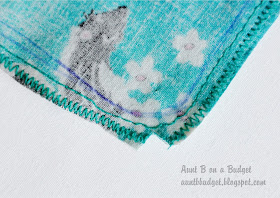Craft projects don't have to be elaborate or complicated to be worth doing. Some things are worth making for exactly the opposite reasons: because they are simple and useful.
Like potholders.
I've never bought one at a store. At my house, potholders are made from old, worn towels and whatever scraps of cotton I have on hand (old clothing, fabric remnants, or thrift store finds).
When the outside coverings on my potholders wear through, I don't throw them away. I re-cover them and continue using them until, finally, they get so thick they won't fit under the presser foot of my sewing machine. Then I retire them to my craft room, where I use them while working with my soldering iron.
I noticed recently that some of my potholders were in need of recovering. Since the process for re-covering a potholder is virtually the same as that for making one brand new, I thought I'd share it with you. It's a simple enough project for novice seamsters and (for those of you with the holidays in mind) could make a useful, thoughtful gift.
Click on any of the photos in this post to be taken to a larger view.
These are the potholders I started with. If you were making potholders from scratch, you'd cut a couple of pieces of old toweling - 7 or 8 inches square - to use instead.
Don't use fabrics containing synthetic fibres for making or re-covering potholders. They won't withstand the heat.
I took the cushion cover apart at the seams and was left with three pieces of fabric.
It looked like the smaller of the two rectangles would be sufficient to cover my potholders. I folded it in half and laid the potholders on the folded fabric just to be sure.
I pressed the piece of fabric from the cushion cover, and folded it in half lengthwise, then laid the two potholders on the fabric, leaving some space between them. I traced around the potholders with a quilting pen.
I removed the potholders from the fabric, corrected any wiggly lines in my tracing, and cut the hanging loops off the potholders, as close to the seam as possible.
Being careful to leave a seam allowance, I cut the folded fabric between the traced outlines of the first and second potholders, and again above the traced outline for the second potholder. This left me with two squares for the covers, and a strip of fabric about two inches wide. I used that narrow strip of fabric to make new hanging loops for the potholders.
First I folded the strip in half lengthwise and pressed along the fold.
Then I opened the folded fabric and folded each outside edge in to meet the crease left by the center fold. I pressed along both new folds.
I laid the untrimmed strip next to the trimmed one and cut it down to about the same length.
I folded both fabric strips in half and placed one inside the cut pieces of each new cover, at an angle from the top corner, with the raw edges of the strips extending above the seam line.
Once the loops were placed, I pinned all of the pieces in place.
I sewed around the edges of each new cover, working just outside the traced line, and leaving most of one side unstitched (an opening into which I could insert the old potholder - or you could insert your pieces of towelling if making a new potholder).
I zigzagged around each cover, just outside the seam line I'd sewn. Then I trimmed the extra fabric away, taking care to leave the seam allowance untrimmed in the area I'd left unstitched for stuffing .
I cut a small notch at each corner to help the seam lie flat once the cover was turned right side out.
Turned right side out, the cover looked like this:
I inserted a potholder into each of the new covers, tucked the seam allowances inside, and hand stitched each opening shut.
All that remained was to quilt the newly covered potholders so that the stuffing would not shift during use or laundering.
I stitched from corner to corner on each potholder, making an "X," then sewed a square about an inch and a half from the outside edge of the potholder.
And that's all there was to it: My newly covered potholders were finished. Kind of cute, don't you think?
Crafter's notes:
- You don't need a fancy machine to do stuff like this. Mine is very basic; sewing only forward, backward, and zigzag. You do need to ensure, though, that you are using a sewing machine needle suitable for working with heavy fabrics.
- If you're making the potholders from new, you may want to baste your layers of toweling together. If they are sewn together, it will be easier to stuff them into the covers and arrange them so they lie flat.
- I've also stuffed potholders with layers cut from worn flannelette sheets. Just be sure to use lots of layers: at least six.
- Old wool suiting or blankets make excellent potholder stuffing too. Wash the wool fabric in very hot water and dry it on the hottest setting on your dryer. It will shrink up and thicken, becoming it very durable.
















